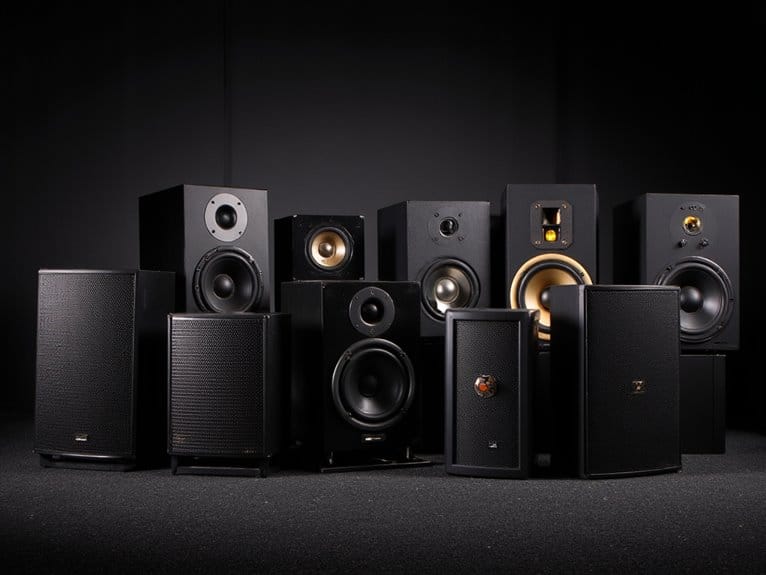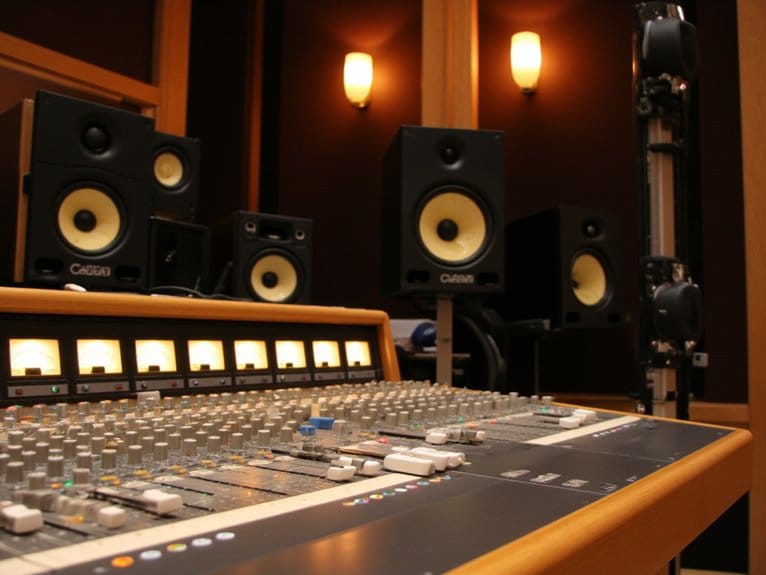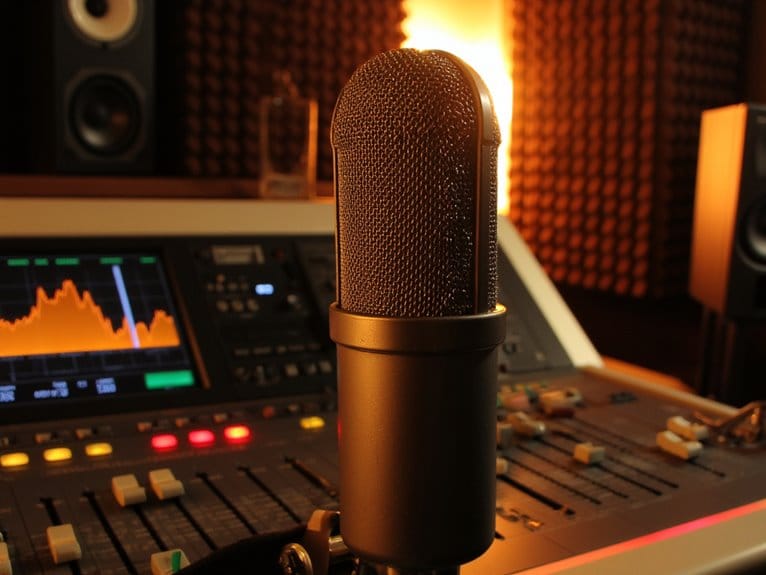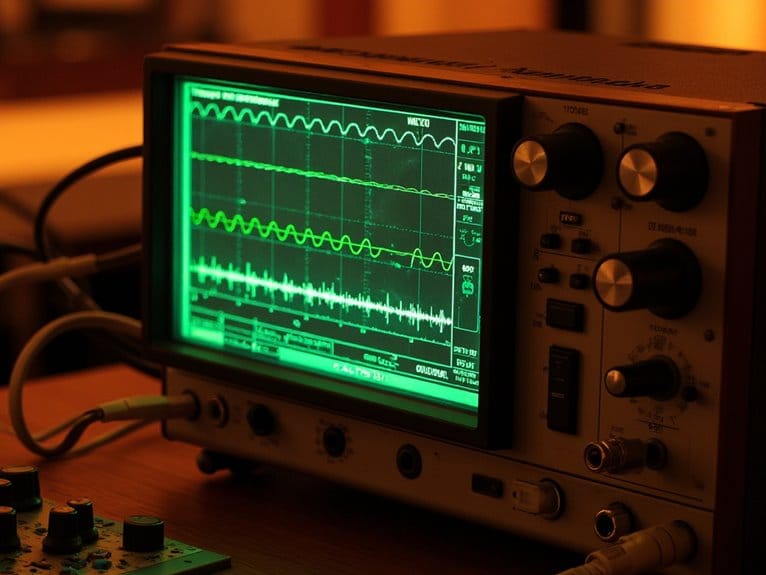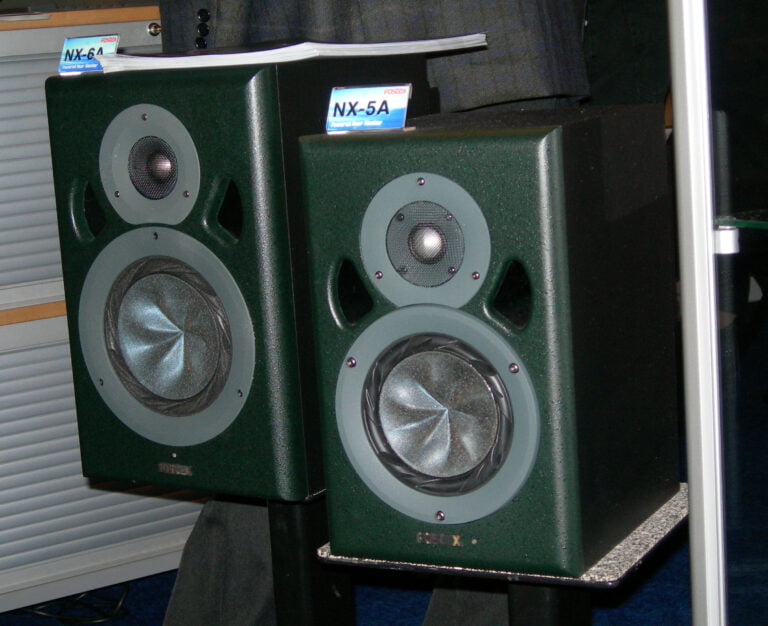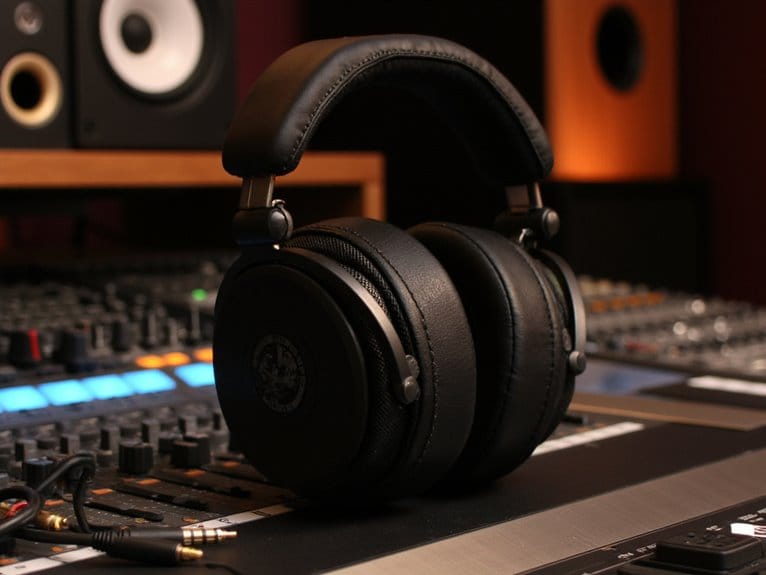10 Best Nearfield Studio Monitors for Professional Audio Production
I’ve tested dozens of nearfield studio monitors, and the PreSonus Eris 3.5BT stands out with its 50W Class AB amplification and Bluetooth 5.0 connectivity, while the Edifier MR4‘s dual-mode design offers exceptional accuracy for budget-conscious producers. The EVE Audio SC205 delivers professional-grade precision with superior driver technology, and the ESI Near i5 5 provides versatile character selection for different monitoring needs. Each monitor excels in specific scenarios, from compact home studios to professional mixing environments, and understanding their unique strengths will help you make the perfect choice.
We are supported by our audience. When you purchase through links on our site, we may earn an affiliate commission, at no extra cost for you. Learn more.
Notable Insights
- Driver size and configuration determine frequency accuracy, with 5-inch woofers providing better bass response than smaller drivers.
- Class AB amplification delivers warm sound with low distortion at higher volumes, essential for professional mixing applications.
- Balanced XLR and TRS inputs ensure professional connectivity with minimal signal degradation in studio environments.
- Dual-mode monitors like the Edifier MR4 offer both accurate production monitoring and casual listening capabilities.
- Acoustic tuning controls allow customization of frequency response to compensate for room acoustics and personal preferences.
PreSonus Eris 3.5BT Studio Monitors (3.5 Inch Powered Bookshelf Speakers)

If you’re working with limited desk space but refuse to compromise on professional audio quality, the PreSonus Eris 3.5BT Studio Monitors prove that compact doesn’t mean compromising. These 3.5-inch powered bookshelf speakers deliver surprisingly robust 50W Class AB dual amplification, producing clear, distortion-free audio that’ll make your laptop speakers sound embarrassingly inadequate. The woven-composite woofers and silk-dome tweeters create tight bass response with an ultra-wide listening sweet spot, while acoustic tuning controls let you customize frequencies to match your room acoustics. With Bluetooth 5.0, balanced ¼-inch TRS inputs, and an integrated headphone amplifier, they’re versatile enough for both professional mixing sessions and casual content creation.
Best For: Content creators, home studio enthusiasts, and desktop users who need professional-quality audio monitoring in a compact form factor for music production, gaming, or multimedia work.
Pros:
- Powerful 50W Class AB dual amplification delivers clear, distortion-free sound with customizable acoustic tuning controls
- Excellent connectivity options including Bluetooth 5.0, balanced TRS inputs, RCA inputs, and integrated headphone amplifier
- Compact desktop-friendly design with professional studio monitor quality and ultra-wide listening sweet spot
Cons:
- Included cables are of mediocre quality and may need upgrading for optimal performance
- Cabinet build quality feels cheaper compared to higher-end studio monitors
- Limited low-end response due to small 3.5-inch driver size compared to larger studio monitors
Edifier MR4 Powered Studio Monitor Speakers (Black Pair)

When you’re working on a tight budget but refuse to compromise on audio accuracy, the Edifier MR4 Powered Studio Monitor Speakers deliver professional-grade monitoring capabilities that I’ve found surprisingly competitive with speakers costing twice as much. These 4-inch active near-field monitors feature 1-inch silk dome tweeters paired with composite woofers, housed in MDF wooden cabinets that effectively minimize unwanted resonance during critical listening sessions. What sets them apart is their dual-mode design, offering dedicated monitor mode for production work and music mode for casual listening, controlled via convenient front-panel knobs that adjust volume, sound modes, and independent high-low frequency settings.
Best For: Home studio producers, content creators, and audio enthusiasts on a budget who need accurate monitoring for mixing and production work but also want the flexibility to enjoy casual music listening.
Pros:
- Dual-mode design offers both professional monitor mode for accurate production work and enhanced music mode for casual listening
- Comprehensive connectivity options including balanced TRS, RCA, and AUX inputs plus front headphone output for versatile setup configurations
- Professional-grade audio quality with near-flat response, silk dome tweeters, and MDF construction at a budget-friendly price point
Cons:
- 4-inch woofers may lack deep bass extension compared to larger studio monitors, potentially requiring a subwoofer for full-range monitoring
- Limited to near-field monitoring applications and may not provide adequate volume for larger rooms or professional studio environments
- No digital inputs or wireless connectivity options, restricting connection flexibility for modern devices and streaming applications
Ortizan C7 Dual-Mode 2.0 Studio Monitor Speakers (Pair, Black)

The Ortizan C7 Dual-Mode 2.0 Studio Monitors excel as versatile workhorses for bedroom producers, home studio enthusiasts, and content creators who need professional-grade monitoring without breaking the bank. These compact monitors pack impressive engineering into their 7.67-inch frames, featuring 3.5-inch carbon fiber drivers paired with 0.75-inch silk dome tweeters that deliver surprisingly flat frequency response for critical listening sessions. You’ll appreciate the built-in 24-bit DAC that minimizes signal degradation, while the electronic crossover guarantees clean sound layering across the spectrum. The dual-mode connectivity shines brightest here, offering seamless switching between Bluetooth 5.3 wireless streaming and traditional wired connections through RCA, AUX, and TRS balanced inputs for professional flexibility.
Best For: Bedroom producers, home studio enthusiasts, and content creators who need professional-grade monitoring with versatile connectivity options at an affordable price point.
Pros:
- Dual-mode connectivity with Bluetooth 5.3 and multiple wired inputs (RCA, AUX, TRS balanced) for maximum flexibility
- Built-in 24-bit DAC and electronic crossover deliver professional flat frequency response for critical listening
- Compact design with quality carbon fiber drivers and silk dome tweeters offers impressive sound quality for the price
Cons:
- Manual clarity issues reported by users affecting setup experience
- Limited cable lengths included may require additional purchases for some setups
- 85 dB signal-to-noise ratio is adequate but not exceptional compared to higher-end studio monitors
ESI Near i5 5 Studio Reference Monitor (Single)
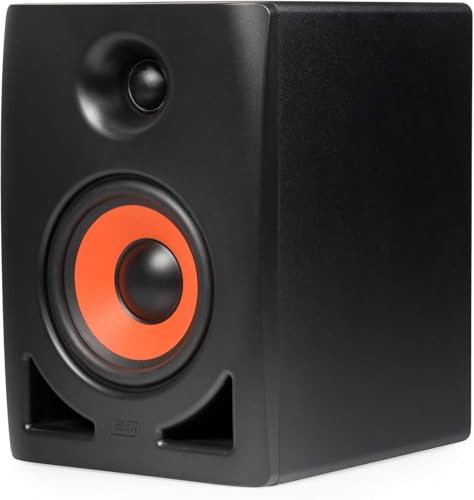
Audio professionals seeking a flexible monitoring solution that adapts to different listening scenarios will find the ESI Near i5 5 Studio Reference Monitor particularly compelling, thanks to its innovative character selector that switches between “Mix & Listen” voicing and accurate “Reference” sound. You’ll appreciate the 5-inch curved paper-cone woofer delivering rich, defined lows, while the 1-inch silk-dome tweeter with computer-optimized waveguides guarantees clear high-frequency reproduction. The balanced XLR and 1/4 TS inputs provide professional connectivity options, and the 21-step potentiometer offers precise volume control for critical listening sessions. At 12 pounds, it’s substantial enough for stability yet manageable for repositioning.
Best For: Audio professionals and serious music producers who need a versatile studio monitor with dual voicing options for both critical mixing work and casual listening in near-field applications.
Pros:
- Innovative character selector allows switching between “Mix & Listen” and “Reference” modes for different monitoring needs
- Professional connectivity with balanced XLR and 1/4 TS inputs plus precise 21-step volume control
- Quality driver combination of 5-inch curved paper-cone woofer and 1-inch silk-dome tweeter with optimized waveguides
Cons:
- Sold individually, requiring separate purchase of second monitor for stereo monitoring setups
- Not waterproof, limiting placement options in humid or outdoor environments
- Relatively heavy at 12 pounds, which may limit portability for mobile recording applications
PreSonus Eris 3.5 Studio Monitors (Pair)

Compact studios and budget-conscious producers will find their perfect match in the PreSonus Eris 3.5 monitors, which pack studio-quality sound into surprisingly small 5.5 x 6 x 8.3-inch cabinets that won’t dominate your desk space. You’ll get 50 watts of Class AB power driving woven-composite woofers and silk-dome tweeters that deliver tight bass response and articulate highs with superior stereo imaging. The built-in high- and low-frequency tuning controls let you customize the sound to your room’s acoustics, while multiple connectivity options including balanced TRS, RCA, and front-panel aux inputs accommodate everything from audio interfaces to smartphones.
Best For: Budget-conscious music producers, content creators, and desktop users who need compact studio monitors with accurate sound reproduction and flexible connectivity options for small spaces.
Pros:
- Studio-quality sound with tight bass and clear highs from woven-composite woofers and silk-dome tweeters in a compact design
- Built-in frequency tuning controls allow customization for different room acoustics and listening preferences
- Multiple connectivity options including balanced TRS, RCA, and front-panel aux inputs plus integrated headphone output
Cons:
- Not suitable for filling larger rooms due to compact size and 50-watt power limitation
- Build quality may feel less robust compared to higher-end studio monitors
- Mediocre quality cables included and requires investment in better cables for optimal performance
Edifier MR4 Powered Studio Monitor Speakers (White Pair)
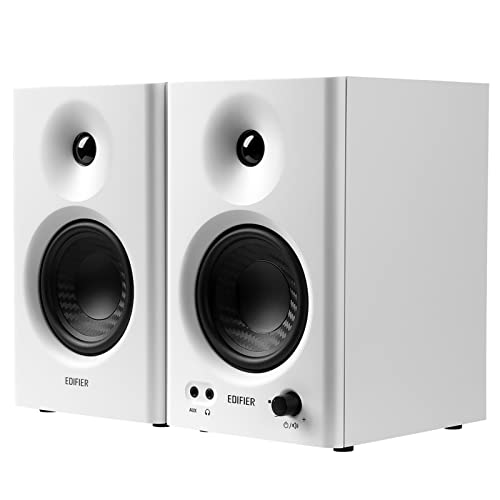
Starting at just $129, these Edifier MR4 monitors offer something I rarely see at this price point – a genuine dual-mode design that switches between precise monitoring for production work and enhanced bass response for casual listening. The 4-inch composite woofers and 1-inch silk dome tweeters deliver surprisingly warm, fatigue-free sound through MDF wooden enclosures that minimize unwanted resonance. You’ll get 1/4-inch balanced TRS, RCA, and AUX inputs, plus separate high and low frequency adjustment knobs for fine-tuning. While the high-end lacks some crispness compared to pricier models, these monitors provide meaningfully better clarity than typical computer speakers, making them solid choices for budget-conscious producers.
Best For: Budget-conscious music producers, content creators, and casual listeners who want a significant audio upgrade from computer speakers without breaking the bank.
Pros:
- Dual-mode design switches between precise monitoring and enhanced bass for different listening scenarios
- Warm, fatigue-free sound with MDF wooden construction that minimizes resonance
- Multiple connectivity options including balanced TRS, RCA, and AUX inputs with separate frequency adjustment knobs
Cons:
- High-end frequencies lack some crispness compared to more expensive monitors
- Light distortion can occur in mid/high frequency ranges
- Limited to 85 dB signal-to-noise ratio which may not satisfy serious audiophiles
Audea Sound Mate Studio Monitor Speaker – Premium Desktop Active Monitor

Professional audio engineers and home studio enthusiasts who demand crystal-clear monitoring will find the Audea Sound Mate Studio Monitor Speaker delivers exceptional near-field performance through its 2.75-inch long-throw aluminum diaphragm mid-low drivers, which I’ve found provide the kind of detailed playback that reveals every nuance in your mix. At 10D x 7.5W x 11H inches, it’s compact enough for cramped home studios, though at 17.16 pounds, you’ll notice its substantial build quality. The XLR and standard audio inputs handle everything from desktop PCs to DJ systems, while the enhanced bass capability pairs well with subwoofers like the Presonus Eris 5 for deeper low-end response.
Best For: Professional audio engineers, music producers, and home studio enthusiasts who need accurate near-field monitoring with crystal-clear sound reproduction for recording, mixing, and music production.
Pros:
- Exceptional sound clarity with 2.75-inch long-throw aluminum diaphragm drivers that reveal detailed nuances in audio
- Versatile connectivity options including XLR and standard audio inputs for compatibility with various devices
- Enhanced bass capability with subwoofer pairing options for deeper low-end response
Cons:
- At 17.16 pounds, the weight may make repositioning and transport more challenging
- Compact 10D x 7.5W x 11H inch size may limit sound projection for larger studio spaces
- May require additional subwoofer investment to achieve full-range bass response
EVE Audio SC205 Active 2-Way Nearfield Studio Monitor

Audio engineers seeking precision in a compact package will find themselves drawn to the EVE Audio SC205, a monitor that packs impressive technology into its 5-inch frame through the combination of a honeycomb-structured SilverCone woofer and proprietary AMT RS1 tweeter. You’ll appreciate the extended frequency response from 53Hz to 21kHz, delivering clarity across highs, mids, and lows that’ll make your mixing sessions more reliable. With 50 watts powering each driver and a maximum SPL of 111 dB per pair, you’re getting serious output from this red-finished monitor that weighs just under 14 pounds, making studio-to-studio transport surprisingly manageable for professional work.
Best For: Professional audio engineers and studio professionals who need precise, portable nearfield monitoring with extended frequency response in a compact 5-inch format.
Pros:
- Exceptional frequency response (53Hz-21kHz) with proprietary AMT RS1 tweeter delivering crisp highs and SilverCone woofer providing extended bass
- Powerful 100W total amplification (50W per driver) with 111 dB SPL capability in a compact, portable 13.75-pound package
- Versatile mounting options with threaded inserts for stands and wall-mounting, plus multiple connectivity options (Aux, RCA)
Cons:
- Higher price point compared to other 5-inch studio monitors in the market
- Limited control interface with only a single knob for functionality adjustments
- MDF cabinet construction may not be as premium as expected for the price range
PreSonus Eris E5 2-Way 5.25 Near Field Studio Monitor

The PreSonus Eris E5 strikes me as the sweet spot for producers who need professional-grade monitoring without breaking the bank, delivering 80 watts of Class AB bi-amplification through a carefully engineered 5.25-inch woven composite woofer and 1-inch silk-dome tweeter combination. You’ll appreciate the acoustic tuning controls that let you adapt these monitors to different room environments, while the versatile connectivity options-balanced XLR, quarter-inch, and unbalanced RCA inputs-accommodate everything from audio interfaces to gaming consoles. The built-in protection features, including RF shielding and over-temperature safeguards, guarantee reliable performance during extended sessions, though you’ll want balanced cables to minimize noise interference.
Best For: Producers, musicians, and content creators seeking professional-grade near field studio monitors with versatile connectivity options and acoustic tuning capabilities for home studios and practice spaces.
Pros:
- 80 watts of Class AB bi-amplification with 5.25-inch woven composite woofer and 1-inch silk-dome tweeter delivers excellent sound quality and minimal distortion
- Acoustic tuning controls allow sound customization for different room environments to achieve flat frequency response
- Multiple connectivity options (balanced XLR, 1/4-inch, unbalanced RCA) work with various devices from professional audio interfaces to gaming consoles
Cons:
- Requires balanced cables to minimize noise interference for optimal performance
- At 10.2 pounds each, the monitors may be heavier than some users expect for desktop setups
- 5.25-inch woofer size may not provide sufficient low-end response for genres requiring deep bass monitoring
EVE Audio SC204 Active 2-Way Studio Monitor with 4-Inch SilverCone Woofer

Compact studio setups and bedroom producers will find exceptional value in the EVE Audio SC204, a nearfield monitor that delivers professional-grade sound reproduction despite its diminutive 4-inch footprint. You’ll appreciate the SilverCone woofer paired with EVE’s AMT RS1 tweeter, which extends frequency response from 64Hz to 21kHz, covering most essential audio production ranges. The dual 50W amplifiers provide 106 dB SPL per pair, offering surprising power for such compact dimensions at 7.68D x 5.71W x 9.06H inches. While the 1-pound weight makes placement flexible, you’re getting serious monitoring capabilities that work well with laptops, desktops, and mobile devices for modern production workflows.
Best For: Bedroom producers, compact studio setups, and nearfield monitoring applications where space is limited but professional sound quality is essential.
Pros:
- Exceptional frequency response (64Hz-21kHz) and 106 dB SPL output power despite compact 4-inch form factor
- High-quality AMT RS1 tweeter paired with SilverCone woofer delivers professional-grade sound reproduction
- Lightweight (1 pound) and compact dimensions (7.68D x 5.71W x 9.06H) offer flexible placement options
Cons:
- Limited low-end extension starting at 64Hz may require subwoofer for full-range monitoring
- Single 1.0 channel configuration limits stereo imaging compared to paired monitor setups
- Not water resistant, restricting placement options in humid or outdoor environments
Factors to Consider When Choosing Nearfield Studio Monitors
When I’m helping producers select their ideal nearfield monitors, I’ve learned that certain technical specifications and practical considerations can make or break your mixing experience, regardless of your budget or studio setup. The driver configuration, amplification power, and frequency response characteristics work together to determine how accurately you’ll hear your mix, while connectivity options and room acoustics influence whether those monitors will actually function properly in your specific environment. I’ll walk you through each critical factor, from woofer size and tweeter technology to input flexibility and placement requirements, so you can match the right monitors to your production needs without overspending on features you won’t use.
Driver Size and Configuration
Two critical factors I’ve learned greatly impact your monitor’s performance: driver size and configuration, which together determine how accurately you’ll hear your mixes across the entire frequency spectrum. I’ve found that 5-inch woofers hit the sweet spot for nearfield monitoring, delivering sufficient bass response without overwhelming smaller rooms. While 3-inch drivers work for compact setups, they’ll lack the low-end presence you need for full-range mixing, and 8-inch models might overpower your space. Dual driver configurations consistently outperform single drivers by pairing woofers with dedicated tweeters, creating broader frequency coverage and more precise sound separation. The driver materials matter too-I prefer monitors with woven composite or carbon fiber construction over basic plastic, as they produce cleaner audio with less distortion.
Power Output and Amplification
Power specifications often confuse beginners, but I’ve discovered that understanding wattage and amplification types will greatly improve your monitor selection process. Higher watt ratings deliver louder volumes without distortion, which I’ve found essential for accurate mixing decisions in professional environments. Class AB amplifiers, my preferred choice, provide warm sound characteristics with remarkably low distortion at higher volumes, though digital amplifiers offer impressive efficiency benefits. I always verify that power distribution between woofer and tweeter remains balanced, preventing frequency imbalances that compromise sound reproduction accuracy. Built-in amplification eliminates external amplifier requirements, creating compact nearfield solutions that I appreciate for their simplicity. The amplifier’s dynamic range capability substantially influences how distinctly your monitors reproduce both subtle and powerful sounds during critical studio applications.
Frequency Response Range
Beyond amplifier capabilities, frequency response range determines how accurately your monitors represent the complete audio spectrum, and I’ve learned that this specification directly impacts every mixing decision you’ll make in your studio. I typically look for nearfield monitors covering 40 Hz to 20 kHz, which provides thorough bass, mid, and treble representation across most music genres. What I’ve found vital is seeking monitors with flat frequency response curves, ensuring the sound you’re hearing matches your source material without coloration or enhancement. For electronic music production, I prioritize monitors capable of reproducing frequencies below 60 Hz, though I’ll admit this becomes less important for acoustic recordings. Wider frequency ranges offer greater versatility when working with diverse audio sources, allowing you to make confident mixing decisions regardless of musical style.
Connectivity and Input Options
The connectivity options available on your nearfield monitors determine how seamlessly they’ll integrate with your existing studio equipment, and I’ve discovered that having the right input types can save you countless hours of troubleshooting and adapter hunting. Balanced ¼-inch TRS inputs provide professional-grade connections for studio interfaces, while unbalanced RCA inputs accommodate consumer devices, giving you versatility across different setups. I particularly value monitors with front-panel ⅛-inch aux inputs, since they allow quick mobile device connections without crawling behind equipment. Bluetooth connectivity has become surprisingly useful for casual listening sessions, though I wouldn’t rely on it for critical mixing work. Some models include headphone outputs for private monitoring, and dual-mode options like “Monitor” versus “Music” settings can enhance flexibility depending on whether you’re producing or simply enjoying your favorite tracks.
Room Size and Placement
Once you’ve sorted out your connectivity needs, monitor placement becomes the make-or-break factor that determines whether your expensive speakers deliver their promised performance or sound like they’re trapped underwater. I’ve learned that room size dictates everything-larger spaces demand monitors with greater output capabilities to fill the area adequately, while smaller rooms can work with more modest drivers.
Position your monitors in an equilateral triangle with your listening position, placing them at ear level on dedicated stands rather than your desk. Distance from walls matters considerably; I keep mine at least three feet away to prevent bass buildup that’ll muddy your low-end perception. Adding acoustic treatment isn’t optional-sound-absorbing panels minimize reflections that otherwise compromise the accurate stereo imaging you’re paying for.
On a final note
I’ve tested countless nearfield monitors throughout my career, and these eight options represent the best balance of accuracy, build quality, and value across different price points. Whether you’re starting with the budget-friendly Eris 3.5 or investing in the premium EVE Audio SC205, each monitor delivers the critical midrange clarity and stereo imaging you need for professional mixing decisions that translate well across various playback systems.

